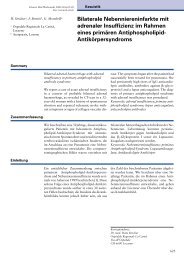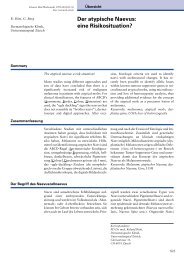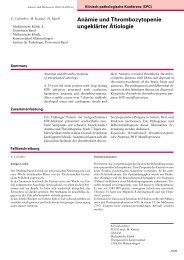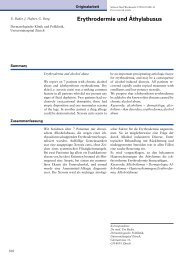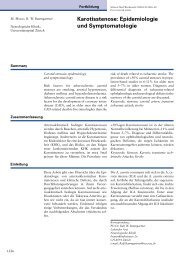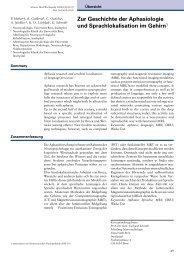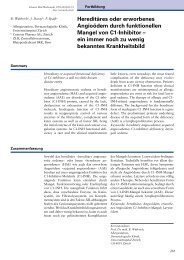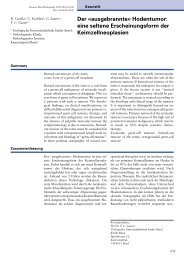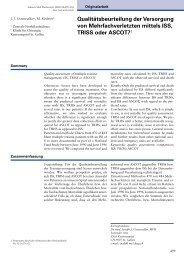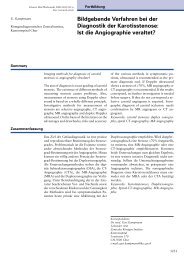Supplementum 163 - Swiss Medical Weekly
Supplementum 163 - Swiss Medical Weekly
Supplementum 163 - Swiss Medical Weekly
Create successful ePaper yourself
Turn your PDF publications into a flip-book with our unique Google optimized e-Paper software.
41 S SWISS MED WKLY 2008;138(Suppl <strong>163</strong>) · www.smw.ch<br />
Poster Viewing<br />
HGF receptor, c-met, is restricted to the peak phase of EAE disease<br />
and is mainly expressed by CD11b+ macrophages/microglia within<br />
demyelinated lesions in the spinal cord. In addition, a small<br />
percentage of CD11c+ dendritic cells (DCs) and NG2+ OPCs were<br />
found to express c-met, whereas CD4+ T-cells were completely<br />
c-met negative. Flowcytometric analysis confirmed these<br />
observations. The timing of c-met expression, with expression<br />
limited to the peak phase of disease, and the robust expression by<br />
macrophages indicates a potential pro-inflammatory role for the<br />
HGF-c-met pathway in EAE.<br />
Subsequent in vitro experiments, using bone marrow-derived<br />
macrophages (BMM), showed that quiescent macrophages do not<br />
express c-met but that c-met mRNA and protein expression can be<br />
induced by treatment with TNF-alpha or LPS. Furthermore,<br />
experiments with soluble TNF receptor and monoclonal anti-TNFalpha<br />
antibodies demonstrated that LPS-induced c-met expression is<br />
mediated via autocrine TNF-alpha signalling.<br />
Although the function of c-met in macrophages remains unclear our<br />
data suggests it plays no role in classical macrophage functions such<br />
as phagocytosis, cytokine secretion and NO production. Currently,<br />
EAE experiments with macrophage-specific c-met knockout mice as<br />
well as gene chip arrays with HGF-treated BMM are being performed<br />
to elucidate the role of c-met in macrophages in EAE.<br />
P180<br />
The role of the pro-apoptotic Bcl-2 family member Bim<br />
in GM-CSF-regulated neutrophil apoptosis<br />
N. Andina, H-U. Simon.<br />
Pharmakologisches Institut (Bern, CH)<br />
Background: Neutrophils are constantly produced in large numbers<br />
in the bone marrow. After maturation, they enter into the circulation<br />
and undergo apoptosis. However, under inflammatory conditions,<br />
neutrophil apoptosis is delayed due to survival factor exposure, and,<br />
consequently, cell numbers increase. An important pro-inflammatory<br />
cytokine involved in the regulation of neutrophil survival/activation is<br />
granulocyte-macrophage colony stimulating factor (GM-CSF).<br />
Although GM-CSF mediates anti-apoptotic effects in neutrophils, it<br />
does not prevent apoptosis, and the survival effect is both timedependent<br />
and limited. We therefore hypothesised that GM-CSF, in<br />
spite of mediating anti-apoptotic effects, allows the activation of proapoptotic<br />
pathways.<br />
Methods: Global gene expression was assessed using<br />
oligonucleotide microarrays. For protein detection cell lysates were<br />
prepared and Bim protein expression was assessed using<br />
immunoblotting. Cell survival was determined by flow cytometric<br />
analysis of ethidium bromide uptake.<br />
Results: Analyzing global gene expression in untreated and GM-CSF<br />
– stimulated human peripheral blood neutrophils revealed that GM-<br />
CSF induced the expression of pro-apoptotic Bcl-2 family member<br />
Bim. To verify these findings, we performed immunoblotting analysis<br />
and observed increased Bim protein levels in GM-CSF – stimulated<br />
blood neutrophils compared to freshly isolated or cultured control<br />
blood neutrophils. Bim upregulation was dependent on de novo<br />
transcription and translation as it was blocked by both cycloheximide<br />
(translation inhibitor) and actinomycin D (transcription inhibitor).<br />
Pharmacological inhibition of PI3K (LY294002) blocked GM-CSF –<br />
mediated survival and, surprisingly, decreased Bim expression in<br />
neutrophils. The functional role of Bim was investigated using Bim<br />
deficient mouse neutrophils. Lack of Bim expression reduced<br />
spontaneous neutrophil death. Moreover, in the absence of Bim, both<br />
GM-CSF and IL-3 demonstrated much higher efficacy to block<br />
neutrophil apoptosis.<br />
Conclusions: These data demonstrate a functional role for Bim in the<br />
regulation of neutrophil apoptosis and suggest that GM-CSF and<br />
other neutrophil hematopoietins initiate a pro-apoptotic counter<br />
regulation that involves up-regulation of Bim.<br />
P181<br />
TGFb receptor II gene deletion in leukocytes exacerbates<br />
experimental autoimmune encephalomyelitis<br />
U. Malipiero1 , F. Ackermann1 , T. Suter1 , W. Reith2 , A. Fontana1 .<br />
1 Universitätsspital Zürich (Zürich, CH); 2 Centre <strong>Medical</strong> Universitaire<br />
(Genève, CH)<br />
The TGFb family of proteins are secreted molecules with potent<br />
immunoregulatory properties. All three isoforms, TGFb -1, -2 or -3,<br />
signal via the same heteromeric receptor complex, consisting of a<br />
ligand binding TGFb receptor type II (TRII) and a TGFb receptor type<br />
I. TGFb -1 secreted by macrophages and monocytes can regulate<br />
many activities of these immune cells such as expression of MHCII,<br />
chemotaxis, production of cytokines and their receptors, production<br />
of reactive oxygen species and nitric oxide. Activation and infiltration<br />
of macrophages is seen in various disease models including<br />
experimental autoimmune encephalomyelitis (EAE). The current study<br />
investigates the role of TGFb on the macrophage compartment in<br />
inflammatory and autoimmune disease models. In order to interrupt<br />
the TGFb-signaling pathway in macrophages, we delete the TRII by<br />
breeding floxed TRII mice with mice expressing Cre recombinase<br />
under the macrophage-specific mouse lysozymeM promoter. The<br />
LPS-induced production of TNFa is not inhibited by TGFb in Creexpressing<br />
macrophages. Macrophages of wildtype animals show a<br />
50–80% reduction of TNFa secretion in the presence of TGFb. The<br />
results show clearly that the TGFb-signaling pathway in macrophages<br />
is not functional. TGFb macrophage receptor knockout mice<br />
immunized with MOG35-55 to develop EAE show a significantly<br />
higher disease score in the late phase of the disease compared to<br />
control animals. Mononuclear cells isolated from the CNS of EAE<br />
mice are currently tested for cytokine production.<br />
P182<br />
Activation of NK cells in drug hypersensitivity<br />
A. Zawodniak1 , B. Gerber1 , T. Kawabata2 , W. Pichler1 .<br />
1 University Berne (Berne, CH); 2 Pfizer (Groton, USA)<br />
Introduction: Cytotoxic cells are critically involved in different forms<br />
of drug hypersensitivity. We have recently shown that drug-specific<br />
cytotoxic T cells can be detected in peripheral blood of drug-allergic<br />
patients. The role of natural killer (NK) cells, as an important<br />
component of innate immunity, in drug induced cytotoxicity has not<br />
been investigated so far.<br />
Methods: To asses whether specific drug stimulation can induce<br />
activation and degranulation of NK cell in peripheral blood of drug<br />
allergic patients, peripheral blood mononuclear cells (PBMC) of drug<br />
allergic patients and healthy subjects were isolated from blood and<br />
frozen. After thawing, PBMC were incubated with medium alone<br />
(negative control), with the culprit drug and superantigen SEB<br />
(positive controls). Following stimulation, three parameters were<br />
evaluated: a) cell surface expression of CD69 as a stimulation marker<br />
and b) CD107a as a degranulation marker by FACS, and c)<br />
measurement of granzymeB production by ELISPOT.<br />
Results: Stimulation of PBMC from allergic patients with the specific<br />
drug lead to the upregulation of CD69 and CD107a on the surface of<br />
NK cells. Delayed upregulation of CD107a (the earliest after 24h) on<br />
NK cells from freshly isolated PBMC correlated with the kinetics of<br />
CD107a expression on CD4 and CD8 T cells. Interestingly, the<br />
percentage of NK cells upregulating CD69 and CD107a after<br />
stimulation with the drug was 10–20 times higher than the percentage<br />
of activated T cells, and was thus a more robust marker for drug<br />
sensitization than the activation of T cells itself. Within total PBMC,<br />
the number of cells releasing granzymeB was much lower and<br />
corresponded better to the number of CD107a-positive T cells,<br />
however. Restimulation after a 7d culture with the drug and antigen<br />
presenting cells caused immediate (5h) degranulation of T cells but<br />
not of NK cells.<br />
Conclusions: Activation of peripheral blood cells of drug allergic<br />
patient by drugs leads to activation of NK cells. This activation is<br />
probably due the cytokines released by drug specific T cells and is<br />
not able to cause a granzymeB-dependent cytolytic activity of NK<br />
cells. Since the reaction of NK cells is stronger than the reaction of<br />
specific T cells, monitoring of NK cell activation may be<br />
advantageous in in vitro testing of drug hypersensitivity.<br />
P183<br />
Towards improvement of structural and functional basis<br />
of TCR avidity for tumour antigen<br />
D.A. Schmid1 , V. Zoete2 , M. B. Irving1 , M. André1 , P. Reichenbach3 ,<br />
V. Posevitz4 , R. Gomez5 , T. Schumacher5 , P. Romero4 , D. Speiser4 ,<br />
O. Michielin2 , N. Rufer1 .<br />
1 Centre Pluridisciplinaire d’Oncologie (Epalinges, CH);<br />
2 <strong>Swiss</strong> Institute of Bioinformatics (Lausanne, CH);<br />
3 ISREC (Epalinges, CH); 4 Ludwig Institute for Cancer Research<br />
(Lausanne, CH); 5 The Netherlands Cancer Institute (Amsterdam, NL)<br />
Background: CD8+ T lymphocytes recognize and destroy virusinfected<br />
or tumor cells. However, the tumor-specific cytotolytic<br />
T lymphocytes often fail to mediate a clinically effective immune<br />
response. A major reason might be the relative lack of high avidity




